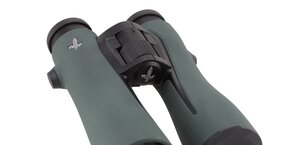Opticron Countryman 8x42 BGA T
The producer states that in 2007 the series was equipped with a 64 layer Oasis reflective coatings – you can find it on one of prism surfaces in order to increase the transmission. Generally all air-to-glass surfaces are to be covered by antireflection multilayer coatings.
Buyers get objective cups, the rainguard, straps and a case. The binoculars come with 10-year guarantee period.
| Magnification | Lens diameter | Angular field of view | Prisms | Eye relief | Weight | Price |
|---|---|---|---|---|---|---|
| 8 | 42 | 109/1000(6.2o) | BaK-4/roof | 19 mm | 635 g | 1170 PLN |
Summary
Pros:
- small, compact casing,
- well-corrected astigmatism,
- slight distortion,
- not very bothersome coma,
- sharp image for most of the field of view,
- not very high light fall-off on the edge of the field,
- high quality BaK-4 glass prisms,
- good whiteness rendering.
Cons:
- narrow field of view,
- the diameter of objectives smaller than the declared 42 mm,
- truncated exit pupils,
- a lot of flares near pupils,
- too narrow maximum IPD,
- noticeable chromatic aberration on the edge of the field of view.
 |
The Opticron Countryman 8x42 BGA T, next to the Fujinon 8x42 MF, the Kowa BD 8x42, the Olympus EXPS I 8x42 and the Pentax ED 8x43 DCF belongs to the group of instruments with the narrowest field of view – their eyepieces have an apparent field of view of about 50 degrees. The following chart shows a comparison between their properties. As you can notice, the Opticron is physically the smallest ant the lightest instrument of all. Although its declared field of view is the narrowest, in reality it is a bit better than in the case of some rivals; the Opticron’s field is wider than declared and other producers have it narrower than stated in their specifications. Still such a field of view we consider too small. In 8x42 class you reach a sensible minimum only with a field of 7 degrees.
 Vixen New Foresta HR 8x42 WP, Opticron Countryman 8x42 BGA T and Delta Optical Forest II 8x42 |
Does the tested Opticron has any other outstanding features, apart from its dimensions and weight? Such a narrow field of view should have been corrected in a perfect way; unfortunately it isn’t. On the other hand the main aberrations are corrected well so you can’t seriously complain about the binoculars’ performance. The shape of exit pupils is quite another story. Not only they are truncated but also the area around them doesn’t look very good. The miniaturization of the dimensions is the reason why the objective lens is a tad smaller than stated in the specifications and the maximum IPD hardly impresses you either – in fact some people might find it too narrow.
 |
If you are interested in a small, handy pair of binoculars and the size of the field of view is not your priority, the Opticron seems to be a quite good choice. It is much cheaper than the Kowa and the Pentax, it fares better than the Fujinon. If the dimensions are not so important, though, the Olympus would be a much better choice, with a superior performance and a lower price tag. On the other hand the Opticron has to face strong competition – such binoculars as the Vixen New Foresta or Steiner Ranger Pro 8x42, keeping roughly a similar price point, offer better optical properties and a wider field of view.

















